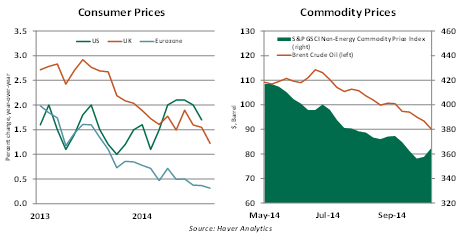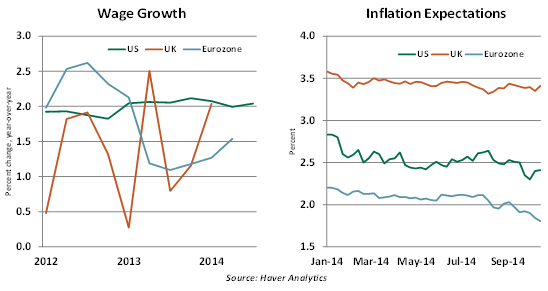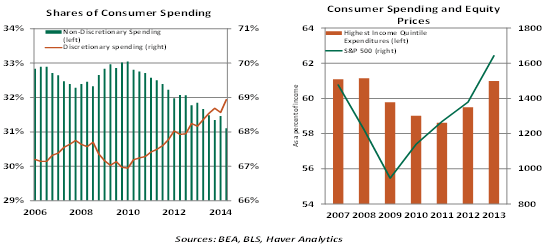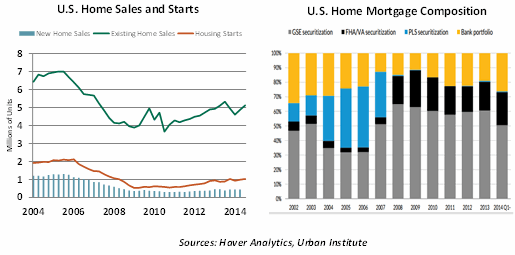- Inflation is falling, but it won’t go through the floor
- Income inequality is affecting consumption categories
- Do new mortgage lending rules strike the right balance?
In my formative years, inflation was the enemy. Oil shocks and improper monetary policy pushed the price level ahead at an unacceptable rate. The consequence was an extended period of underperformance, which required radical measures to reverse.
Some think that inflation has become the enemy again but in a different way. Thirty years ago, inflation was perniciously high, and expectations called for it to stay that way. Today, inflation is falling, and inflation expectations are following suit. Price stability is essential, but prices that are too stable can present problems as well.
The present global disinflation presents policymakers with a difficult challenge. Having used radical measures to work through the financial crisis, there is little capacity left to put a floor under the price level. Doing so will require careful coordination across countries and between fiscal and monetary strategy. Recent history suggests that this will not be easy to engineer.
The global recovery that began in 2009 has been modest and uneven. As an expansion continues, the supply of resources typically dwindles and their prices increase. But such has not been the case this time around. Inflation has been falling steadily over the past 12 months, even in countries like the United States, where economic growth has been relatively strong.

On a "headline" basis, falling oil prices have had an important influence. Supplies have risen since the beginning of the summer; analysts suspect that some suppliers have temporarily increased their output to hinder their strategic rivals. Gasoline prices in the United States have consequently fallen by $0.60 per gallon since July.
Because energy prices can be volatile, many prefer to look at “core” inflation measures, which exclude them. But energy costs influence the prices of other products, particularly through the cost of transportation.
The prices of other commodities have also declined quite a bit in recent months. A leading cause of this trend is the slowing in Chinese manufacturing, which reflects soft demand from Europe and substantial inventories of both raw materials and finished product.
 To address economic underperformance, policymakers in the eurozone engineered a decline in the euro in the hope of expanding exports. This means cheaper imports for those on the other side of these transactions, which also serves to hold down inflation. As more and more countries seek competitiveness through currency depreciation, the dollar and the pound may gather further strength.
To address economic underperformance, policymakers in the eurozone engineered a decline in the euro in the hope of expanding exports. This means cheaper imports for those on the other side of these transactions, which also serves to hold down inflation. As more and more countries seek competitiveness through currency depreciation, the dollar and the pound may gather further strength.
And finally, wages in developed countries are stalled. Lingering underemployment across regions has limited increases in pay, and in turn, limited the upward pressure on prices.

This condition may persist for quite a while, as there is considerable labor capacity around the globe. When times are slow, firms typically limit pay increases but stop short of reducing wages; during the early phases of expansion, firms may hold back on increases as a way of restoring equilibrium. Federal Reserve Chair Janet Yellen mentioned this “pent-up wage disinflation” in a speech over the summer.
As investors added this up, their outlooks for future inflation fell. Market-based measures of such expectations have fallen quite a bit over the past two months. Because these readings are drawn from a period where trading has been somewhat volatile, caution should be exercised before taking them at face value. That said, once inflation expectations become entrenched, they are difficult to dislodge.
Many central banks seek a 2% rate of inflation. This is not a ceiling but rather a target to achieve over some period of time. When inflation falls below this ideal level, the real value of debt increases; this makes it more difficult to repay. Further, disinflation can turn into deflation, which risks paralyzing consumption.
If inflation is going to be lower for longer, so will interest rates. The Bank of England, which once seemed on track to begin normalizing policy before year-end, appears to have backed away from that schedule. The Fed is not likely to signal any change in policy when it meets next week.
 Given the weight of recent headlines, it would be tempting to embrace a forecast of further declines in inflation. But this expectation may not be realized. Energy prices are unlikely to continue declining at their recent pace; suppliers will likely move to restrict output at some point to preserve margins. The cost of lodging, which is a leading ingredient in the Consumer Price Index basket, is rising. Prices for services are progressing by more than 2% annually.
Given the weight of recent headlines, it would be tempting to embrace a forecast of further declines in inflation. But this expectation may not be realized. Energy prices are unlikely to continue declining at their recent pace; suppliers will likely move to restrict output at some point to preserve margins. The cost of lodging, which is a leading ingredient in the Consumer Price Index basket, is rising. Prices for services are progressing by more than 2% annually.
Absent a full-fledged currency war, stronger countries will not import that much deflation. And the massive expansion in monetary reserves around the world could eventually press upward on the price level. It hasn’t happened yet, but that does not mean that it will never happen.
When I started my career, I never thought inflation would get as low as it has. I certainly could not have imagined that if it did, it would be viewed as a problem. Inflation may be lower than it was 30 years ago, but it can still present big challenges.
How You Earn, and What You Buy
The subpar recovery after the Great Recession resulted in weak and unbalanced gains in income, which has spurred a debate about income inequality in the United States. Studies of this development have highlighted various root causes and offered prescriptions to address the result. As policymakers continue to debate future solutions, today’s trends in consumer spending reflect the current state of income inequality.
A typical basket of consumer goods and services consists of food, shelter, clothing, health care, financial services, entertainment and so on. Differentiating between these goods and services based on whether they are discretionary items (luxuries) or non-discretionary items (necessities) offers a glimpse about underlying income trends driving consumers.
The fraction of what people spend on expenditures such as food, shelter and clothing tends to decline as income advances. By contrast, discretionary expenditures such as vacations, jewelry and pleasure boats are more sensitive to changes in income trends.
According to the Fed’s Survey of Consumer Finances, during 1989-2013, the average income of the top 5% of households rose 38%, while the average income of the remaining 95% grew only 5%. This should benefit outlays on luxuries, which are typically concentrated in the upper part of the income distribution.
Consistent with these expectations, the share of discretionary spending in total consumer spending is
accelerating compared with non-discretionary items. Sales at high-end stores (Tiffany, Nordstrom) increased around 75% during 2006-2013 compared with growth of a little more than 25% at lower- and middle-income stores (Walmart, Target, Kohl’s, J.C. Penney, Best Buy, Sears, Family Dollar).

Data from the Consumer Expenditure Survey, published by the Bureau 3f Labor Statistics, indicates a sharp increase in expenditures of the top income quintile as percent of income during 2011-2013 as equity prices advanced. Going forward, if income gains are not widespread, the mix of goods and services consumers are purchasing is most likely to represent the shares visible now.
Consumer spending, in the aggregate, will continue to advance in the quarters ahead, but the message from the headline may be different from that of its underlying composition.
New Mortgage Lending Rules: Will It Help Home Sales?
The U.S. economy is in a relatively strong position, but the housing sector is not yet hitting on all cylinders. Tight lending standards are one of the factors holding back momentum in the housing sector. Federal regulators passed new rules this week to ease conditions for mortgage lending. Will these new rules help the housing sector?
Sales of new and existing homes have barely moved up in the past four quarters. Construction of new homes is largely concentrated in the multi-family sector. Employment conditions have strengthened noticeably in recent months, but income growth is tepid. Mortgage rates are close to historical lows, while mortgage lending conditions are tight.
Under the Dodd-Frank Act, it was proposed that lenders would need to hold 5% of the risk from mortgages they package and sell to investors. Otherwise, a 20% down payment from borrowers would be necessary to get a loan. Loans sold to GSEs (government-sponsored enterprises such as Fannie Mae and Freddie Mac) are not subject to the risk-retention stipulation.
 Under the new law, effective as of fall 2015, lenders are not required to hold 5% of the risk as long as they can verify the borrower’s ability to repay the loan and debt payments do not exceed 43% of their income. The new regulations eliminate the 20% down-payment requirement. In addition, there are proposals that would reduce down payment requirements on mortgages sold to GSEs, potentially to as low as 3%.
Under the new law, effective as of fall 2015, lenders are not required to hold 5% of the risk as long as they can verify the borrower’s ability to repay the loan and debt payments do not exceed 43% of their income. The new regulations eliminate the 20% down-payment requirement. In addition, there are proposals that would reduce down payment requirements on mortgages sold to GSEs, potentially to as low as 3%.

Relaxing underwriting standards should give a lift to home sales, provided employment and mortgage rates remain favorable. The 30-year mortgage rate at 4% is down roughly 60 basis points since August 2013, which should also be helpful.
The change in underwriting standards should enable banks to increase their loan portfolios without as much fear of running afoul of new regulations. The uncertainty surrounding the lack of definition in this area has been cited as the enemy of intermediation, and the air has been cleared somewhat.
Still, there are those who are not entirely happy about these developments. They fear that the hard-earned lessons of 2008 have not been translated well into new mortgage guidelines and wonder if economic stimulus took precedence over financial prudence as the rules were finalized.
For an industry whose results have swung broadly and where the pendulum of regulation also has varied widely over time, defining the new normal is especially important. Let’s just hope that we’ve centered things appropriately.
.
Recommended Content
Editors’ Picks
EUR/USD alternates gains with losses near 1.0720 post-US PCE

The bullish tone in the Greenback motivates EUR/USD to maintain its daily range in the low 1.070s in the wake of firmer-than-estimated US inflation data measured by the PCE.
GBP/USD clings to gains just above 1.2500 on US PCE

GBP/USD keeps its uptrend unchanged and navigates the area beyond 1.2500 the figure amidst slight gains in the US Dollar following the release of US inflation tracked by the PCE.
Gold keeps its daily gains near $2,350 following US inflation

Gold prices maintain their constructive bias around $2,350 after US inflation data gauged by the PCE surpassed consensus in March and US yields trade with slight losses following recent peaks.
Bitcoin Weekly Forecast: BTC’s next breakout could propel it to $80,000 Premium

Bitcoin’s recent price consolidation could be nearing its end as technical indicators and on-chain metrics suggest a potential upward breakout. However, this move would not be straightforward and could punish impatient investors.
Week ahead – Hawkish risk as Fed and NFP on tap, Eurozone data eyed too

Fed meets on Wednesday as US inflation stays elevated. Will Friday’s jobs report bring relief or more angst for the markets? Eurozone flash GDP and CPI numbers in focus for the Euro.